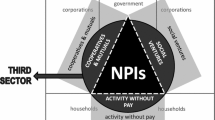Abstract
Building on a previousVoluntas article (Salamon and Anheier, 1992b), which formulated a systematic approach to defining the non-profit sector for purposes of comparative research, this article takes on the complementary task of formulating a classification system that can be used to differentiate systematically the types of non-profit organisations that exist at the global level. To do so, the article first assesses a number of existing classification systems, such as the International Standard Industrial Classification and the National Taxonomy of Exempt Entities. Finding these systems inadequate, the article then introduces an alternative system, which we term the International Classification of Nonprofit Organizations (ICNPO). The ICNPO classifies non-profit establishments into 12 major groups based on their primary economic activity, and then further sub-divides these into 24 sub-groups. The result is a system that scores high in terms of five key evaluation criteria: economy, significance, rigour, organising power, and richness. What is more, initial tests of the ICNPO in a set of countries show that it performs well in coming to terms with the diverse types of non-profit institutions that exist around the world.
Similar content being viewed by others
References
Amenomori, T. (1992) The nonprofit sector, mimeograph, Johns Hopkins Comparative Nonprofit Sector Project, Baltimore, Maryland.
Anheier, H., Salamon, L.M. and Rudney, G. (1992) The nonprofit sector in the United Nation's system of national accounts: definition, treatment and practice,Working Papers of the Johns Hopkins Comparative Nonprofit Sector Project, no. 4, Institute for Policy Studies, Johns Hopkins University, Baltimore, Maryland.
Archambault, E. (1992) Defining the nonprofit dector: France,Working Papers of the Johns Hopkins Comparative Nonprofit Sector Project, no.7, Institute for Policy Studies, Johns Hopkins University, Baltimore, Maryland.
Deutsch, K. (1963)The Nerves of Government, Free Press, New York.
Drabek, A.G. (ed.) (1987) Development alternatives: the challenge for NGOs,World Development, 15, Special Issue.
Eurostat (1979)European System of Integrated Accounts (ESA), second edition, Office for Official Publications of the European Community, Luxembourg.
Eurostat (1985)NACE: General Industrial Classification of Economic Activities within the European Communities, Office for Official Publications of the European Community, Luxembourg.
Eurostat (1992)NACE: General Industrial Classification of Economic Activities within the European Communities, first revised edition, Office for Official Publications of the European Community, Luxembourg.
Hodgkinson, V.A. (1990) Mapping the non-profit sector in the United States: implications for research,Voluntas, 1:2, 6–32.
Institut National de la Statistique et des Etudes Economiques (INSEE)Enquête sur les Associations, INSEE, Paris.
Salamon, L.M. (1992)America's Nonprofit Sector: A Primer, The Foundation Center, New York.
Salamon, L.M. and Abramson, A.J. (1982)The Federal Budget and the Nonprofit Sector, The Urban Institute Press, Washington, DC.
Salamon, L.M. and Anheier, H. (1992a) Toward an understanding of the nonprofit sector at the international level: the Johns Hopkins Comparative Nonprofit Sector Project,Nonprofit Management and Leadership, 2, 311–24.
Salamon, L.M. and Anheier, H. (1992b) In search of the nonprofit sector. I: The question of definitions,Voluntas, 3:2, 125–51.
Sumariwalla, R. (1983) Preliminary observation on scope, size, and classification of the Sector,Working Papers for the Spring Research Forum: Since the Filer Commission, Independent Sector, Washington, DC.
United Nations (1990)International Standard Industrial Classification of All Economic Activities, third revised edition (Statistical Papers Series M, no. 4, rev. 3).
Additional information
Lester Salamon is Professor at the Johns Hopkins University, Baltimore, Maryland 21218 and Director of the Institute for Policy Studies there.
Helmut Anheier is Research Scientist at the Institute for Policy Studies at the Johns Hopkins University and Assistant Professor of Sociology at Rutgers University, New Brunswick, New Jersey, 08903. He is co-editor ofVoluntas.
The authors are grateful to Kusuma Cunningham for her assistance in developing the ICNPO and for compiling Appendix C of this paper.
Rights and permissions
About this article
Cite this article
Salamon, L.M., Anheier, H.K. In search of the non-profit sector II: The problem of classification. Voluntas 3, 267–309 (1992). https://doi.org/10.1007/BF01397460
Issue Date:
DOI: https://doi.org/10.1007/BF01397460




